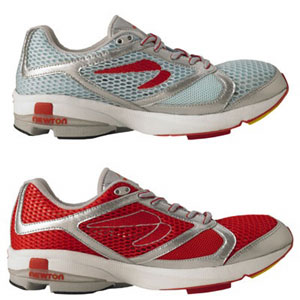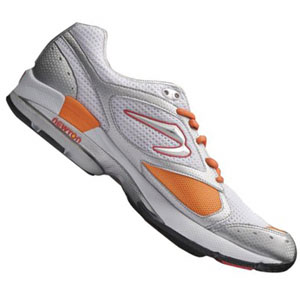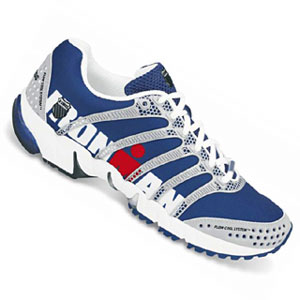Newton: a second look

Earlier this year I wrote a short piece about Newton shoes. I had my first pair for just a few weeks and didn't run too much in them because Newton says you should gradually build up your mileage in its shoes. I also cast doubt, in this earlier article, that you would be faster in Newton shoes. Well, I have to retract that statement. But let me first tell you what I experienced in the intervening 6 months.
To really enjoy Newtons you have to understand the philosophy behind the shoes and, as I read a lot of other articles about the shoes as well as a lot comments from users on different forums, I can tell a lot of people don't. I'm not going to explain how they work. I'm sure almost every athlete with interest in training gear visited Newton’s website and knows that there are lugs under the forefoot.
What I will try to explain is the difference between the traditional way of running and how Newton shoes need to be used. Note the picture containing three cubes. You can see that the heel strike means your heel meets the ground at a sharp angle, which is in a way of breaking your own speed. The second phase is when your feet are flat on the ground and the nex,t of course, your push-off phase.
In this way of running you don't have a smooth transition from heel to toe. To some it may looks that way, but, just stand up and put your heel with some force to the ground as you would do while running. You can feel the impact on your body and because your leg is in front of your body the upper leg muscles can hardly help your body absorb the impact of your heel strike. A lot of stress is put to your knees, hips and lower back.

Instead, make a strike with your mid foot, or, with just a very light heel strike. This is difficult-approaching-impossible if you don't shorten your stride. And, you need to shorten your stride length quite a bit more than just a couple of inches. This is easier if you lean slightly forward with your whole body, not just (as some forums suggest) with your upper body.
So, lean forward slightly with your whole body and don't bend at the hips. If you then run with a shorter stride you will see that you will almost immediately adopt a midfoot strike, and place your leg under your hips. This affords your body a lot less impact stress and, I believe, help solve knee, lower back and hip injuries.
But if you shorten your stride and you want to run at the same speed or faster you need to increase your run cadence. We don't need to reference the laws of thermodynamics to understand this. It’s also about increasing your running cadence.
Another mistake I read on forums is that, while running in Newtons, your heel may not contact the ground at all; that you should run on your toes. That's a complete misunderstanding of how these shoes work. It's no problem to have a slight contact at the heel, rather you don't want to have an aggressive heel strike. If you shorten your stride this almost instantly happens with most people so it's a natural way of running. This is what Newton Running is all about.
If you’re currently a heel striker you might argue that this is your natural gait, so, why change it? Well, your “natural” style will disappear if you run barefoot for 50 yards. You’ll notice that without your shoes you don't make a heel strike. Your body doesn't like a heel strike, but, we developed this style since we wear shoes almost from the day we learn to walk. That's way a heel-strike gait may feel natural to you, but, it really isn't.
When you take a look at how the Kenyans, Ethiopians or other African runners run, not one of them is running with a heel strike. They run naturally.
So don't try these shoes unless you are willing to jettison heel-striking. Newton shoes won't work for you.

However, if you are runner with chronic knee issues, shin splints, or any other overpronation related injuries you may want to give Newtons a try. Because of the slighter angle at which your heel/midfoot strikes the ground while landing the lever is so much smaller, thus the movement causing overpronation is much less.
And with the leg more under your hips instead of in front of your hips the upper leg muscles can help to absorb the impact of each stride. But you will use your calves a bit more, and your Achilles tendons that attach your calves to your heels. At first you can and probably will feel this, hence Newton’s admonition to slowly adapt to its shoes.
For most new Newton users I would recommend alternating with a standard pair of running shoes. After a few weeks maybe two runs in your Newtons and one with your other shoes. And so on. You will see that this different running style is demanding on your connective tissue. I, for example felt it in my calves for the first serious runs. But I confess I didn’t ease into my new Newtons as I’m suggesting you do
Nevertheless, as our store’s guinea pig I run in so many different shoes. So, alternating in the beginning will let your gradually adjust to a more natural way of running.
Alternatively, the latest models in the Newton range, the Sir and Lady Isaac (pictured just above), are made for an easier transition from standard to Newton. These models feature a heightened heel relative to the forefoot.
But: Are they faster?
I was wrong in my article earlier this year. If you run in them the way you should, I believe they are faster than standard training and racing shoes.
My evidence: For the last 4 months I've been doing 10K training runs on the same course on a regular base; almost every week at least once on this same course. Every third time I ran in Newton shoes. I did these runs all with the same average heart rate. Yes, weather conditions varied, and my fitness increased steadily during the season, but, without exception I was always faster in the Newtons.
I also noted I was faster when running the Newton “style” in regular shoes versus the standard way in standard training shoes. So based on this you could say that this more natural running form is always better than the standard way.
Other notes: When I started training longer distances in the Newtons I noticed that my calves were getting stronger, but I also had a lot less stress the day after a long run (more than 15 miles). I recuperated a lot faster. Was it the Newtons, or my newly-developed running technique? In any case, it is certainly not my experience the Newtons are ill-advised for longer runs.
Mileage per pair: I wore two pairs throughout the last six months, a trainer and a racer. I’ve got significant mileage on both and the wear on the outsole (which is primarily wear on the lug) is appropriate, in my opinion.
Are there no negative points to mention on the Newton running shoes? In my view there are some.
Both racers and performance trainers feel a bit slippery on wet surfaces. They tackled this problem with the All-Weather shoe. They placed a non-slippery rubber on the lugs so you feel there is more grip; this rubber is also placed on the outsole of the new Isaac.
The second—and this is what concerns me the most—is that I found that the upper is so flexible that it stretches out. After only after a handful of runs I had to tighten the laces to get the same fit. During the first few runs they fitted snug and nice but a few runs later they tend to get a bit looser and wider. Now I have to tighten my first pair much tighter than when new and they tend to wrinkle a bit at the base of the tongue. I'm looking forward to comments from other Newton users, to see if my experience with the upper is unique.
But overall I have to say I'm impressed with the shoes, and more yet about the attempt to educate runners in how to run, and that there is a shoe made for this technique. Let’s see how adroitly Newton develops new models; maybe even a tri-specific shoe.
[Editor’s note: Our capable editor-at-large for footwear Jeroen van Geelen owns Total Running, one of the more important running and triathlon retail establishments in The Netherlands.]



Start the discussion at slowtwitch.northend.network